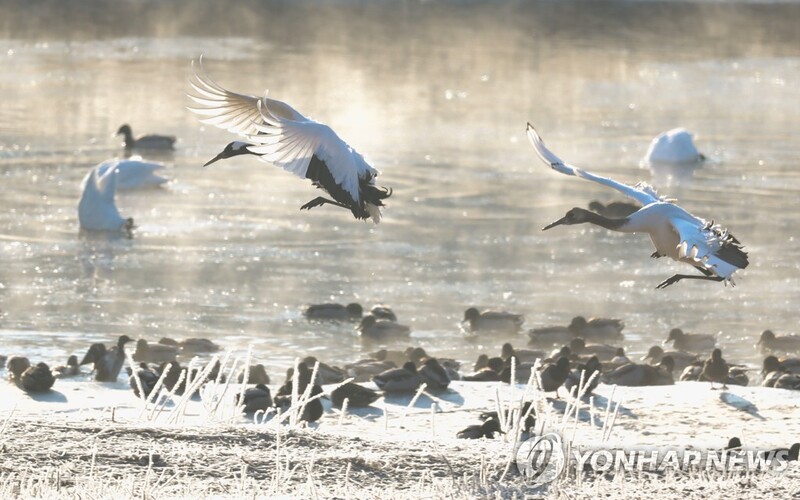 |
| ▲ This file photo shows Red-crowned cranes in the Choerwon Plain. (Yonhap) |
 |
| ▲ This file photo shows White-naped cranes in the Choerwon Plain. (Yonhap) |
 |
| ▲ This file photo shows both Red-crowned and White-naped cranes. (Yonhap) |
SEOUL, Jan. 17 (Yonhap) – A study in the latest issue of The Journal of the Ornithological Society of Korea has addressed the noticeable change in the demographic variables of Red-crowned and White-naped Cranes in the Choerwon Plain from 2003 to 20022.
According to the paper titled “Twenty-year population trends of two Red-crowned and White-naped cranes wintering in Cheorwon Plain, Republic of Korea,” the population size of Red-crowned cranes wintering in the Cherwon Plain has dramatically increased, from 600 in 2003 to more than 1,200 birds in 2022, despite the evident habitat deterioration. The population of White-naped cranes has even shown a more steep increase, from about 600 cranes in 2003 to more than 5,500 in 2022.
The wintering population temporarily did decrease around 2010, owing to habitat deterioration – the size of the civilian-controlled area where cranes can stably inhabit decreased by 4.3 square kilometers (7.9%) due to the increase in the number of greenhouses and cattle sheds built, along with road expansion and solar power generation facilities constructed.
Nevertheless, the authors of the study explicated that the number of Red-crowned and White-naped cranes incessantly increased until recently thanks to the favorable breeding conditions. Desertification – a consequence of livestock grazing –, which has been accelerating in Russia’s Hankaho Wetland and Amur River where cranes usually breed, has not yet proceeded at a similar pace in South Korea. This was witnessed by the increasing population of Red-crowned and White-naped crane fledglings spending winter in Cheorwon Plain by 19.8% and 17.0%, respectively.
The large-scale cultivation that was not carried out since the late 2010s, along with the creation of rice paddies and remaining bundles of rice straw scattered around the Plain also contributed to the increasing wintering population.
The authors also pointed out climate change as one of the incremental factors: “The agricultural land near the Demilitarized Zone (DMZ) in South Korea is an important wintering site for Red-crowned cranes,” adding, “Since 2000, the wintering population has outnumbered the cranes wintering in Japan’s Izumi due to climate factors such as reduced snow.”
The Red-crowned crane, the bird engraved on the 500-won coin, is a natural monument as well as first-class endangered wildlife that is known to have about 3,000 left worldwide. The bird is characterized by its red head and white body.
Meanwhile, the white-naped crane is also a natural monument that has been designated as second-class endangered wildlife. This breed is characterized by its red cheek and black stomach.
(This article is translated from Korean to English by Ha eun Lee)
(END)
(C) Yonhap News Agency. All Rights Reserved














![[방송 소식] MBC 대학가요제 13년 만에 부활…26일 방송](https://korean-vibe.com/news/data/20251024/yna1065624915904676_716_thum.jpg)
![[신간] 레넌과 매카트니는 경쟁자였을까…'존 앤드 폴'](https://korean-vibe.com/news/data/20251024/yna1065624915904305_293.jpg)







